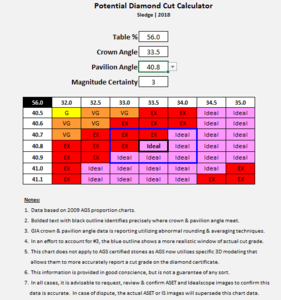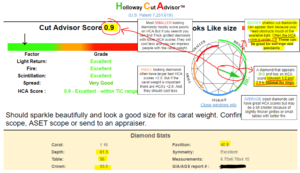You are using an out of date browser. It may not display this or other websites correctly.
You should upgrade or use an alternative browser.
You should upgrade or use an alternative browser.
Floresence and HCA
- Thread starter Dia123
- Start date
- Joined
- Dec 17, 2008
- Messages
- 28,182
Should you avoid medium blue and go for faint or none?
No, there is no reason to avoid med blue. In only a few instances strong blue has a negative effect on the stone. It is rare though.
Below 2 is great but what's the magic number?
2 and below is the magic number if you are referring to the HCA. The HCA is sort of a go/no go tool. Anything below 2 is worth a further look.
Even some stones slightly over 2 can be worth a further look with Idealscope or Aset images.
Thanks all who answer
- Joined
- Jul 31, 2014
- Messages
- 20,043
- Joined
- Apr 23, 2018
- Messages
- 5,870
From a performance standpoint, there is little risk in purchasing a stone with medium fluor. However, you are always wise to perform due diligence and make sure the stone doesn't have a milky or cloudy appearance as result. Typically that occurs in strong to very strong levels and in a handful of stones.
The caveat being, despite it being a small percentage real problem the bulk of buyers view it as a negative. Consequently stones with higher levels of fluor trade for discounted rates. Savvy buyers will perform their due diligence and may opt to move forward with a purchase due to cost savings. The immediate positives being cost savings and no impact on performance. The negative being the stone may be harder to resell in the future to a private individual if they aren't equally as savvy about fluor. If you trade in with a vendor that has a good policy, it's a moot point.
You should read up further and make your own determination/preference. The majority of fluor is blue but it can be in other shades. Blue fluor can help whiten a stone a little. Its minimal overall, and not a reason to solely choose IMO but the bluenhelps offset yellow undertones slightly. So buyers interested in lower colors and higher levels of blue fluor may find some benefit in that regard. The opposite seems to be true as well, where people liking fluor tend to dislike higher levels of fluor in higher colored stones so a D/E stone with strong fluor may be less attractive than a J/K stone with strong fluor.
Another trait of fluor that people sometimes dislike is that under UV lighting the fluor gets excited and activates creating a blue glow of sorts. In a night club with black UV lighting this could be a positive or negative depending on your views. In other areas not as extreme it doesn't glow per se but may still emit a bluish look which some find undesirable.
As far as the HCA 1-2 is preferred for engagement rings. Lower than 1 is also okay but may be preferred for earrings, etc. Sometimes a score.of 2-3 will be okay but it takes additional research to confirm symmetry and light performance.
The HCA scores utilize the proportions of the stone to give you an APPROXIMATION of expected performance. Just remember the crown and pavilion angles you enter from a GIA report are rounded and averaged to the nearest 0.5 for crown or nearest 0.1 for pavilion. There is actually 8 crown and 8 pavilion angles where this data derives. With AGS, they just average and don't round.
Regardless you are taking manipulated data and running more assumptions based on those averages and end up with an HCA score. So while the HCA is taking into account many factors and does a good job guessing, it isn't a perfect science either. Hence part of the reason no "perfect" scores exist. I might add that IMO, a good HCA score is just one of the steps involved in buying a well cut stone. Next you'd want to review and analyze ASET, idealscope and/or H&A images if they are available.
The caveat being, despite it being a small percentage real problem the bulk of buyers view it as a negative. Consequently stones with higher levels of fluor trade for discounted rates. Savvy buyers will perform their due diligence and may opt to move forward with a purchase due to cost savings. The immediate positives being cost savings and no impact on performance. The negative being the stone may be harder to resell in the future to a private individual if they aren't equally as savvy about fluor. If you trade in with a vendor that has a good policy, it's a moot point.
You should read up further and make your own determination/preference. The majority of fluor is blue but it can be in other shades. Blue fluor can help whiten a stone a little. Its minimal overall, and not a reason to solely choose IMO but the bluenhelps offset yellow undertones slightly. So buyers interested in lower colors and higher levels of blue fluor may find some benefit in that regard. The opposite seems to be true as well, where people liking fluor tend to dislike higher levels of fluor in higher colored stones so a D/E stone with strong fluor may be less attractive than a J/K stone with strong fluor.
Another trait of fluor that people sometimes dislike is that under UV lighting the fluor gets excited and activates creating a blue glow of sorts. In a night club with black UV lighting this could be a positive or negative depending on your views. In other areas not as extreme it doesn't glow per se but may still emit a bluish look which some find undesirable.
As far as the HCA 1-2 is preferred for engagement rings. Lower than 1 is also okay but may be preferred for earrings, etc. Sometimes a score.of 2-3 will be okay but it takes additional research to confirm symmetry and light performance.
The HCA scores utilize the proportions of the stone to give you an APPROXIMATION of expected performance. Just remember the crown and pavilion angles you enter from a GIA report are rounded and averaged to the nearest 0.5 for crown or nearest 0.1 for pavilion. There is actually 8 crown and 8 pavilion angles where this data derives. With AGS, they just average and don't round.
Regardless you are taking manipulated data and running more assumptions based on those averages and end up with an HCA score. So while the HCA is taking into account many factors and does a good job guessing, it isn't a perfect science either. Hence part of the reason no "perfect" scores exist. I might add that IMO, a good HCA score is just one of the steps involved in buying a well cut stone. Next you'd want to review and analyze ASET, idealscope and/or H&A images if they are available.
@sledge @lovedogs @tyty333.
I managed to find a video of the 1.16 We talked about on another post thats gone now.
Any opinions or reasons not to buy? http://www.yadavjewelry.com/diamonds/videos/7246581
abit of a final check /confidence boost that im on the right track and its a good stone.
I managed to find a video of the 1.16 We talked about on another post thats gone now.
Any opinions or reasons not to buy? http://www.yadavjewelry.com/diamonds/videos/7246581
abit of a final check /confidence boost that im on the right track and its a good stone.
- Joined
- Apr 23, 2018
- Messages
- 5,870
@sledge @lovedogs @tyty333.
I managed to find a video of the 1.16 We talked about on another post thats gone now.
Any opinions or reasons not to buy? http://www.yadavjewelry.com/diamonds/videos/7246581
abit of a final check /confidence boost that im on the right track and its a good stone.
I'm not sure if it was you, or another member considering this and one other stone. That thread is now deleted, and I see where you asked about how to delete a thread.
Either way, I will withhold linking to the diamond itself.
Proportions are : 56 table, 61.3 depth, 33.5 crown, 40.8 pavilion & 75 LGF
As noted in my other response, you have a shallow crown and shallow depth, which is accounting for the lower 0.9 HCA score. Below is a screen cap of the HCA w/ the GIA number blanked out for your review.
Although paired with a complimentary pavilion angle, I personally don't like the shallow crown angle. General rule is shallow crown and big tables equals more white light return. Steeper crowns and smaller tables equal more fire. It's not that this is "wrong" it's just I would PREFER to maximize fire. If you are indeed the one that posted the other thread, I still prefer the 35.5/40.6 combo for this reason.
Also, are you or your beloved color sensitive? In the video I am picking up a warm buttery tone. Some love it, some don't. Not everyone has the same color sensitive and/or preference for color. For instance I tend to like more white, or brown tints when you go color as opposed to yellow tints. Many don't care for the brown tints.
But when buying a J, you have to expect some tint. Just keep in mind, colors are graded by humans and they are a RANGE, meaning you can have highs & lows in the same color range. Also, as you go further down the color scale, the ranges get larger. So a D will have a very narrow range, where a J will have more variance. Depending on your color sensitivity or preference for tint, you may seek a high (almost I) J or a low J (almost K) or maybe it just doesn't matter that much to you.
Just making you aware before you hit the buy button.
Lastly, if you can request an ASET or idealscope image to confirm light performance, that would be very useful. If a H&A image is available that would confirm symmetry. Depending how well cut the stone is (or not) it could slip from an ideal range to an excellent range in a crude spreadsheet analysis I ran using AGS proportions chart data.


I'm not sure if it was you, or another member considering this and one other stone. That thread is now deleted, and I see where you asked about how to delete a thread.
Either way, I will withhold linking to the diamond itself.
Proportions are : 56 table, 61.3 depth, 33.5 crown, 40.8 pavilion & 75 LGF
As noted in my other response, you have a shallow crown and shallow depth, which is accounting for the lower 0.9 HCA score. Below is a screen cap of the HCA w/ the GIA number blanked out for your review.
Although paired with a complimentary pavilion angle, I personally don't like the shallow crown angle. General rule is shallow crown and big tables equals more white light return. Steeper crowns and smaller tables equal more fire. It's not that this is "wrong" it's just I would PREFER to maximize fire. If you are indeed the one that posted the other thread, I still prefer the 35.5/40.6 combo for this reason.
Also, are you or your beloved color sensitive? In the video I am picking up a warm buttery tone. Some love it, some don't. Not everyone has the same color sensitive and/or preference for color. For instance I tend to like more white, or brown tints when you go color as opposed to yellow tints. Many don't care for the brown tints.
But when buying a J, you have to expect some tint. Just keep in mind, colors are graded by humans and they are a RANGE, meaning you can have highs & lows in the same color range. Also, as you go further down the color scale, the ranges get larger. So a D will have a very narrow range, where a J will have more variance. Depending on your color sensitivity or preference for tint, you may seek a high (almost I) J or a low J (almost K) or maybe it just doesn't matter that much to you.
Just making you aware before you hit the buy button.
Lastly, if you can request an ASET or idealscope image to confirm light performance, that would be very useful. If a H&A image is available that would confirm symmetry. Depending how well cut the stone is (or not) it could slip from an ideal range to an excellent range in a crude spreadsheet analysis I ran using AGS proportions chart data.

I'm not sure if it was you, or another member considering this and one other stone. That thread is now deleted, and I see where you asked about how to delete a thread.
Either way, I will withhold linking to the diamond itself.
Proportions are : 56 table, 61.3 depth, 33.5 crown, 40.8 pavilion & 75 LGF
As noted in my other response, you have a shallow crown and shallow depth, which is accounting for the lower 0.9 HCA score. Below is a screen cap of the HCA w/ the GIA number blanked out for your review.
Although paired with a complimentary pavilion angle, I personally don't like the shallow crown angle. General rule is shallow crown and big tables equals more white light return. Steeper crowns and smaller tables equal more fire. It's not that this is "wrong" it's just I would PREFER to maximize fire. If you are indeed the one that posted the other thread, I still prefer the 35.5/40.6 combo for this reason.
Also, are you or your beloved color sensitive? In the video I am picking up a warm buttery tone. Some love it, some don't. Not everyone has the same color sensitive and/or preference for color. For instance I tend to like more white, or brown tints when you go color as opposed to yellow tints. Many don't care for the brown tints.
But when buying a J, you have to expect some tint. Just keep in mind, colors are graded by humans and they are a RANGE, meaning you can have highs & lows in the same color range. Also, as you go further down the color scale, the ranges get larger. So a D will have a very narrow range, where a J will have more variance. Depending on your color sensitivity or preference for tint, you may seek a high (almost I) J or a low J (almost K) or maybe it just doesn't matter that much to you.
Just making you aware before you hit the buy button.
Lastly, if you can request an ASET or idealscope image to confirm light performance, that would be very useful. If a H&A image is available that would confirm symmetry. Depending how well cut the stone is (or not) it could slip from an ideal range to an excellent range in a crude spreadsheet analysis I ran using AGS proportions chart data.

Great write up thanks so much. Other than the other 1.05 mentioned did you spot any others around 4500usd. Would you advise against a J and go up a few on the colour scale. Does that 1.05 mentioned have the same buttery yellow in youe opinion? The 1.05 is still availble for me, perhaps losing some slight size thats the one to go for?!
Share:







300x240.png)